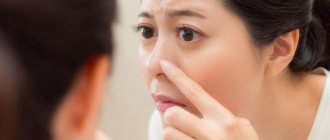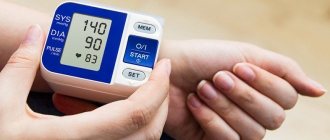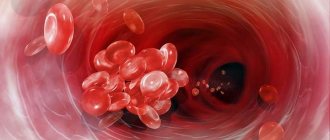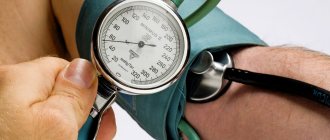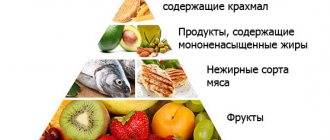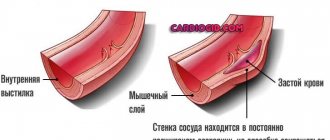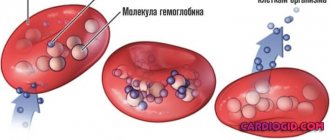What to do if your gums are bleeding: what could be the cause of the symptom and how to stop it correctly
Bleeding gums is one of the most common symptoms indicating the onset of a pathological process in the oral cavity. Due to the absence of pain and other disturbing manifestations at first, many deliberately ignore the problem, believing that it will disappear by itself. Such a symptom may indeed be the result of a common soft tissue injury, but in other cases it becomes a direct signal indicating the development of a dental disease or a disorder in the functioning of internal organs and systems. Today we’ll figure out why gums may bleed when brushing your teeth and what to do about it.
Video
The presented video describes the causes of bleeding gums and the possible consequences that arise in the absence of adequate treatment for this phenomenon. An effective method of combating the disease using green walnut peel is proposed: recommendations are given on the method of preparing the medicinal product and methods of its use.
The presence of inflammatory processes in the oral cavity requires timely consultation with a doctor to accurately diagnose the disease and prevent the development of complications (gum detachment, exposure of the neck of teeth and their loss). Treatment of bleeding at home is recommended in combination with professional dental therapy methods.
Possible causes of bleeding gums
Your gums may bleed when brushing your teeth or when biting into hard foods. In other situations, the symptom manifests itself unexpectedly, in the absence of external stimuli. In any case, the problem cannot be ignored. If you notice characteristic signs in yourself, be sure to contact your dentist. The most common cause of bleeding is insufficient oral hygiene, abundant accumulation of soft and hard plaque, including in the subgingival area.
In the course of their life, bacteria release various toxins that literally corrode hard and soft tissues, thereby provoking inflammatory processes. Over time, this leads to the formation of pathological periodontal pockets, in which deposits continue to accumulate. This is followed by carious processes, the first signs of gingivitis, and then periodontitis. In fact, there are quite a lot of potential causes that can lead to bleeding, so let's look at the main ones.
Gingivitis – inflammation of the upper mucosal epithelium
Inflammation of the mucosal surface, which manifests itself in the form of redness, swelling, pain and bleeding. If you ignore the problem, the symptoms will become more intense and may bother you even at night. Lack of timely treatment will lead to the spread of inflammation into the deeper layers of soft tissue and the development of periodontitis. The diagnosis is quite common among both adults and children. However, the disease is completely curable. The main thing is to seek qualified help in time.
The photo shows gingivitis
Stomatitis with painful ulcers
Damage to the mucous membrane, which is accompanied by increased salivation, the appearance of an unpleasant odor, the formation of a whitish or yellowish coating, as well as painful ulcers. The disease is often found among children, and one of the main factors of the bacterial form of the pathology is poor hygiene - abundant accumulation of plaque and tartar.
The development of stomatitis can also be triggered by a sharp drop in the body’s immune defense, problems with the stomach and intestines, or an allergic reaction. The mucous membrane turns red in one place or over the entire surface of the alveolar ridge, swelling and discomfort appear, turning into painful sensations.
Stomatitis is common in children
Periodontitis and periodontal disease
When the inflammatory process moves into the deeper layers of the mucosa and spreads to periodontal tissue, signs of periodontitis appear. The pathology is widespread and at the same time quite complex. It is considered impossible to completely cure the disease, but achieving stable remission is quite possible - for this you will have to undergo quite a long complex treatment. When the disease takes an acute form, the gums swell and begin to hurt very much, bleeding appears, the mucous membrane becomes inflamed and swells.
With periodontitis, the gums become swollen, begin to hurt and bleed
The aggressive form of periodontitis against the background of long-term treatment can provoke the appearance of signs of periodontal disease. This diagnosis itself is quite rare and has nothing to do with the inflammatory process. Periodontal disease in its original understanding is a gradual atrophy of soft tissues and ligaments. In this case, the mucous membrane becomes pale, noticeably thinner and weakens. But today, periodontal disease as an independent disease has been excluded from the latest list of diseases, and now it is usually considered as a complication of periodontitis.
Mechanical injury
Sometimes bloody marks on a toothbrush only indicate damage to the mucous membrane. This often happens due to bad habits, such as chewing the end of a pencil or brushing your teeth too vigorously, as well as due to improperly installed fillings, crowns or dentures that rub and injure healthy tissue. A similar situation is typical during the period of getting used to braces.
During the process of getting used to braces, inflammation and swelling may occur.
Therefore, there is no need to sound the alarm ahead of time. First, you should carefully examine the oral cavity in the causative area, and it is better to immediately seek advice from a specialist. Even if the symptom is the result of a scratch, it is necessary to ensure proper healing of the wound. The doctor will prescribe antiseptic rinses to prevent infection and infection.
System-wide disorders and hormonal changes
Sometimes the symptom fades away against the background of system-wide disorders. Therefore, when making a diagnosis, you should also consider other possible symptoms that indicate problems with blood clotting or weakness of the vessel walls. In this matter, the only correct decision would be to rely on professional diagnostics from a specialist.
Among the factors that can trigger bleeding, experts identify the following phenomena and conditions:
- acute form of vitamin deficiency, for example, vitamin C deficiency,
- pregnancy period, against the background of hormonal changes in the body and weakening of the walls of blood vessels,
- constant exposure to nicotine smoke when smoking, which negatively affects the strength and elasticity of the walls of blood vessels, greatly thins them and makes them fragile,
- oncological pathologies and conditions arising during their aggressive treatment,
- hemophilia is a disease of the hematopoietic system in which the blood composition is characterized by a deficiency of certain coagulation proteins,
- diabetes,
- viral infections,
- autoimmune diseases,
- liver diseases.
This problem also occurs during pregnancy.
Bleeding is the result of a huge number of potential conditions, many of which are quite serious. If you notice such a symptom, it is better not to hesitate to consult a doctor.
Taking certain medications
The action of certain medications is aimed at thinning the blood, but sometimes this effect leads to bleeding. Usually the symptom disappears on its own, immediately after stopping the medication. But if the bleeding is pronounced and does not go away, it is better to consult a doctor.
Gum diseases
Bleeding often develops due to the development of inflammatory processes in the oral cavity. This symptom is characteristic of periodontitis , gingivitis , periodontal disease and other diseases. The main signal for a visit to the dentist should be the regular appearance of blood while brushing your teeth - in such a situation, you should not postpone a consultation with a doctor.
Gingivitis
This is an inflammation of the gums, in which swelling and swelling of the area affected by the pathological process develops. The patient develops plaque on the teeth, both soft and hard. In these places there is a concentration of microbes. The reasons for the development of gingivitis are improper oral care in smokers, since smoking reduces the level of vitamin C in the body and worsens the condition of the mucous membrane. Gingivitis can develop against the background of diabetes , tuberculosis , tonsillitis , influenza , etc.
In more rare cases, this disease is a consequence of chronic injury to the gums by orthopedic structures or fillings. Since with gingivitis the development of pathogenic microorganisms in the oral cavity is activated, durable deposits appear on the teeth, which over time turn into tartar . Most often, this disease is diagnosed in young people and children. Gingivitis can be viral, bacterial or fungal.
Periodontitis
This disease is associated with the development of an inflammatory process in the dental ligament, which contains a lot of blood vessels. With periodontitis, not only bleeding is a concern, but also possible loosening of the teeth. Since the nutrition of the alveolar edge of the jaw deteriorates, the chewing load on the teeth is redistributed, and they begin to actively wear out. Injury to the gums occurs.
With periodontitis, the tissues around the teeth become inflamed, and the alveolar process of the jaw may gradually collapse. In addition, over time, so-called gum pockets appear, where pus and plaque accumulate. As a result, the teeth become loose and the dental necks are exposed. Both acute and chronic course of the disease is possible. If you do not take the necessary measures, the dentition gradually diverges, becoming like a fan, and the teeth fall out.
Periodontal disease
If a person is concerned about bleeding, then a visit to the doctor is also important from the point of view of the need to exclude such a dangerous disease as periodontal disease . In this disease, degenerative processes predominate over inflammatory ones. Periodontal disease can cause gums to bleed and teeth to become loose. This disease can progress over a long period of time. To diagnose it, you need not only a thorough examination by the dentist, but also an x-ray.
Your child’s gums are bleeding – what could be the cause?
In childhood, a fairly common diagnosis is gingivitis, the main manifestations of which are bleeding and pain. Usually the cause is insufficient oral hygiene, irregular teeth brushing, the presence of abundant plaque and dental deposits due to the abuse of sweets and carbonated drinks. All this leads not only to the development of caries, but also to inflammation of the mucous membrane. Another prerequisite is the period of eruption of baby or permanent teeth.
Poor oral hygiene leads to caries and inflammation of the mucous membrane
Another common cause of problems with teeth and gums in a child can be a traumatic incorrect bite; orthodontic treatment with the installation of a brace system will help correct the situation. Against the background of a cold and weakened immunity, stomatitis often develops - damage to the oral mucosa, which is accompanied by inflammation, the formation of plaque and ulcers, pain and bleeding. All these problems are completely solvable, but it is important to recognize disturbing symptoms in time and begin treatment in a timely manner.
Vitamins to strengthen gums
Many people think that gums bleed from mechanical damage - sharp food debris or brushing with very hard hairs. But, if we follow this logic, then our gums would bleed constantly. In fact, healthy gums can easily withstand the pressure of even the hard bristles of a toothbrush. And only when there is a large deficiency in the body of the vitamins it needs, noticeable bleeding of the gums begins.
To prevent this problem, you must first balance your diet. Turning to antibiotics is still an extreme measure, undesirable due to the abundance of side effects of synthetic antimicrobial agents. But food products with vitamins necessary for the human body do not have such negative properties. Therefore, first of all, you should pay attention to the presence of vitamins in your diet. Vitamins for strengthening gums are primarily vitamins E, K, B and C. When they begin to be lacking, the gums immediately make themselves felt - with swelling and the appearance of blood when brushing your teeth, at the slightest carelessness or simply when eating hard foods like crackers .
Add more vegetables and fruits to your menu, as well as foods containing calcium and phosphorus. Without them, healthy teeth are impossible. You need to eat more cottage cheese, spinach leaves, soybeans, and legumes. Vitamin C and all kinds of citrus fruits will also be indispensable in the fight against blood on the gums. Parsley, red pepper, cod meat and corn - these products are designed to compensate for the lack of vitamins C, E and potassium. And to make blood vessels stronger, you can supplement your diet with spicy spices. Sea salt, sesame seeds and cinnamon will prevent gum inflammation and slow down the growth of bacteria.
Experts believe that vitamin deficiency is one of the most important reasons that lead to bleeding gums. That is why in the winter-spring period, when the body literally screams about the lack of necessary microelements, gums often bleed. Knowing this, take care in advance to make up for the lack of vitamins.
Bleeding gums cannot be ignored, as it may indicate such a serious disease as periodontitis. First, the patient's gums bleed. Then tartar appears on the teeth, which aggravates caries, and the gums will bleed much more often and more severely. Healing periodontitis will already require enormous efforts. The bad thing is that it also affects the entire body: it provokes heart disease and tumors. In order to prevent periodontitis, pay attention to osteoprotectors - drugs for strengthening bone tissue. For example, the drug Osteomed increases bone mineral density and includes all the vitamins that teeth need, as well as a unique natural component, drone brood, which improves hormonal levels. By introducing foods rich in vitamins and minerals and dietary supplements into your diet, you can gradually reduce bleeding gums to nothing.
USEFUL TO KNOW:
ABOUT JOINT DISEASES
How to avoid joint pain?
JOINTS Author: admin625.12.2018Leave a comment
No one thinks about how to avoid pain in the joints - the thunder hasn’t struck, why install a lightning rod. Meanwhile, arthralgia - the name of this type of pain - affects half of people over forty and 90% of those over seventy. So preventing joint pain is something worth considering, even if you...
Read more
ABOUT HORMONE THERAPY
The power of hormones. What active substances regulate cartilage restoration?
HORMONES Author: admin1110.12.2018 Leave a comment
A person’s condition and the coherence of the organs of his body are largely determined by hormonal balance. Cartilage restoration is also subject to the influence of ubiquitous life regulators. Without normalizing hormonal levels, complete regeneration of the joint is impossible. What strings does the invisible puppeteer, the endocrine system, pull, influencing cartilage tissue? Testosterone This hormone is produced by the gonads and the adrenal cortex, as in...
Read more
ABOUT BONE DISEASES
A wrist fracture is a common injury. What should first aid be?
BONES Author: admin1114.10.2020
During a fall, we instinctively put our hands forward, trying to protect our head and face. For this reason, one of the most common injuries is a wrist fracture. According to statistics, it accounts for 35% of all visits to a traumatologist. Long-term wearing of a cast often results in partial atrophy of the muscles of the hand and wrist and their loss of functionality. The latest Russian development...
Read more
ABOUT CONNECTIVE TISSUE DISEASES
ABOUT VITAMINS FOR BONES
May there always be sunshine! What is vitamin D for?
VITAMINSAuthor: admin311.12.2018Leave a comment
Sunlight for a person is not only a source of good mood, joy and happiness. When it comes into contact with the retina and skin, a large number of physiological processes are triggered in the body, for example, the synthesis of calciferol. What is vitamin D for, besides improving calcium absorption? How to compensate for its deficiency if exposure to ultraviolet rays of the sun is undesirable for a person? For…
Read more
DIAGNOSIS OF OSTEOPOROSIS
Diagnostic features
In order to choose the right treatment tactics and provide an integrated approach to solving the problem, it is important to first conduct a competent and comprehensive diagnosis. X-ray examination is only one of the mandatory diagnostic measures, but far from the only one. The best option would be to undergo a computed tomography (CT) scan, which provides the most detailed and informative image in 3D format. With its help, the doctor will be able to assess the real current state of affairs, the condition of not only the soft tissues, but also the jaw bone.
3D diagnostics makes it possible to study the problem in more detail
In diagnosing diseases of the oral mucosa, be it gingivitis or periodontitis, a differentiated approach is also necessary. A comprehensive examination will help you understand what exactly became the “trigger” - poor hygiene or pathological disruptions in the body. Thus, to obtain answers to all of the above questions, the following activities are carried out in dentistry today:
- visual and instrumental examination allows us to assess the depth of periodontal pockets and the volume of deposits in both the supra- and subgingival areas,
- collecting information about the patient’s current condition, that is, communicating about complaints and accompanying symptoms,
- CT for a more accurate assessment of the condition of the periodontium and the degree of destruction of the jaw bone in the presence of atrophic processes,
- seeding of deposits from periodontal pockets for aerobic microflora and sensitivity to certain medications,
- blood tests for sugar, hormone levels and vitamins if necessary.
If it is not so difficult to determine the signs of gingivitis, because it is an inflammation of the upper layer of the mucous membrane with its redness, swelling and pain, then with periodontitis the pathological process spreads deeper into the periodontium and periodontium. Over time, inflammation reaches the ligamentous apparatus and leads to tooth mobility. In this case, the process is accompanied by the formation of voluminous periodontal pockets in which bacteria and food debris, plaque and dental deposits accumulate, which further aggravates the clinical picture.
Only a specialist can make a correct diagnosis
Thus, periodontitis usually manifests itself with the following symptoms: aching pain while eating, bleeding, redness or darkening of the mucous membrane, especially in the area of the gingival papillae, bad breath due to abundant deposits in periodontal pockets and their suppuration, recession (lowering) of the level mucous membrane simultaneously with gradual atrophy, that is, destruction of bone tissue. Mobility as a consequence of disruption of the ligamentous apparatus occurs in the later stages of the disease. At the same time, the acute phase is also accompanied by a general deterioration in health, fever, and weakness. The appearance of at least some of these symptoms should alert you and become a good reason to seek professional diagnosis.
Description of the disease
Blood protruding from the gums does not always cause pain or other discomfort, but this phenomenon is not considered normal. The sign cannot be ignored, since gingivitis is the cause of unpleasant odor from the mouth and a harbinger of periodontitis. If the process is not stopped, inflammation of the periodontium that holds the tooth leads to gum rejection. A poorly fixed tooth becomes loose and falls out.
Bacteria accumulate in places where the tissue does not adhere to the tooth. Under favorable conditions, microflora multiplies, spreading throughout the oral cavity, penetrating into the internal organs. It is worth noting that further developments do not bode well, since bacterial flora can provoke heart disease, stroke, digestive dysfunction, and disruption of the pancreas.
How to eliminate bleeding - treatment features
Before moving on to treating a symptom, you need to find out the cause of its occurrence. Adequate therapy is impossible without making an accurate diagnosis and identifying the original source of the problem. In any case, first you will have to undergo a professional cleaning procedure to remove plaque and solid deposits. Then anti-inflammatory therapy must be carried out. Let's take a closer look at the therapeutic and preventive measures that are universal and mandatory in the treatment of periodontal diseases.
Comprehensive oral hygiene
An effective method for removing soft and hard plaque is professional cleaning using ultrasound, for example, the Vector device. If there are no dental problems, it is enough to undergo this procedure once every six months for prevention. But proper comprehensive hygiene should not be limited to just removing plaque and tartar - in fact, there should be a multi-step approach to cleansing the enamel and normalizing the condition of the mucous membrane.
Only complex treatment, taking into account the individual characteristics of the patient’s clinical picture, will help achieve a noticeable improvement in the condition of the gums, elimination of areas of inflammation and bleeding, and a pronounced whitening effect due to the removal of plaque and pigmented areas. Listed below are 5 main areas that are used in combination to cleanse enamel and improve gum health:
- removing deposits using a scaler - through a special tip, the device delivers ultrasonic waves and microvibrations, which together contribute to the destruction of tartar. At the same time, a small amount of cooling water is supplied to prevent overheating of the enamel, as well as to wash out crushed particles. To carry out this procedure, a laser can also be used, the action of which is based on light waves rather than vibration. The laser provides a targeted effect on problem areas, promotes the breakdown of deposits without harmful effects on the enamel and mucous membranes. Its use is considered more gentle without sacrificing quality and efficiency,
- air-abrasive cleaning with Air-Flow - carried out after removing solid deposits. It can be used as an independent technology, but with an integrated approach it always becomes an addition to ultrasonic or laser treatment. A jet of water mixed with tiny abrasive particles, the size of which does not exceed 14 microns (micrometers), is supplied through the tip under high pressure. The method helps to clean interdental spaces and other hard-to-reach places,
The photo shows the method of brushing teeth with the Air Flow system. - enamel polishing – the top layer of teeth has a porous structure. Composite materials also lose their density over time. Bacteria and coloring pigments accumulate in micropores. To level the enamel surface, polishing is carried out using special abrasive pastes. The individually selected product is applied using a brush with a rotating head,
- strengthening dental tissues - involves fluoridation by applying fluoride varnish in the form of a gel to the enamel. The product relieves sensitivity, strengthens the outer layer of teeth, forming a special protective film that prevents bacterial attack. To avoid damaging this film, experts advise refraining from eating or drinking for an hour after the procedure.
Fluoridation will help strengthen tooth enamel - restoration of gums: due to the removal of supra- and subgingival deposits, natural normalization of the mucous membrane occurs, since the main factor contributing to the development of inflammation disappears. As additional measures, the mucous membrane is treated with a special antimicrobial solution and covered with a soothing hydrogel that stimulates the regenerative functions of epithelial cells and tissues. A resorbable membrane is also fixed - collagen plastic, impregnated with extracts of medicinal plants. It effectively relieves inflammation, promotes compaction of soft tissues, and restores their strength and elasticity. The membrane dissolves on its own within an hour, so there is no need to remove it.
“For problems with gums, professional cleaning should be based on an integrated approach and nothing else. Removing plaque and tartar alone is not enough - comprehensive treatment is necessary, including the affected areas of the mucosa. We use both special membranes with natural ingredients and modern effective drugs that promote the regeneration and restoration of soft tissues. At the same time, not only complexity, but also systematicity is important. You should undergo comprehensive hygiene at least once every six months,” explains Olga Aleksandrovna Belyaeva, dental hygienist and expert in artistic restoration of teeth at one of the leading dental centers in Moscow.
It should be noted that against the background of inflamed periodontal disease, the accumulation of bacterial plaque occurs much faster and more intensely. At the junction of the tooth and the mucous membrane, periodontal pockets are formed, in which bacteria and food debris also accumulate. Removing deposits from there is much more difficult, and sometimes it is necessary to resort to more radical measures - closed or open curettage of the gums. In the first case, the doctor removes deposits from under the gums using special hook instruments - a simple method, but not very effective for pockets more than 5 mm deep.
The photo shows the closed curettage procedure
Open curettage involves cutting the mucosa, cleaning and treating the root area, polishing the root and then suturing after all manipulations. Accordingly, rehabilitation in this case will be more complex and lengthy, but the procedure is effective and guarantees a long-term result.
Anti-inflammatory therapy
Typically, the course of anti-inflammatory therapy lasts from 8 to 10 days. Carrying out therapeutic measures at home involves regular rinsing with antiseptics and anti-inflammatory drugs, the use of special gels and ointments in the form of applications or by external use. After diagnosing and identifying the cause of the problem, the dentist will definitely explain in detail how to treat the inflamed tissues and what exactly to rinse them with. Infusions and decoctions of medicinal herbs can provide a certain effect in this regard, but they can only be used after consultation with a doctor.
Gargling with medicinal herbs will help in treatment
“At one time I tried to rinse with oak bark, but, to be honest, I didn’t notice much effect. Moreover, I often forgot to do this, so the bleeding either went away or reappeared. Then the doctor advised me to buy Cholisal, and it really helped. As soon as I notice the first signs of inflammation, I immediately start rinsing..."
Elena_Mir., from correspondence on the forum www.32top.ru
The standard scheme comes down to treating the soft tissues of the oral cavity twice a day - morning and evening. It is also important to remember to rinse your mouth every time after eating. For minor inflammation in the initial stage, it is usually sufficient to use chlorhexidine at a concentration of 0.05%. If the symptoms are more acute, antiseptic solutions may be prescribed at a concentration of 0.2-0.25%. Doctors also often prescribe the use of “Cholisal” or “Parodontocide” gels.
Preparations for regeneration of bone and soft tissue cells
In advanced cases, when inflammation has already led to the development of periodontitis, there is a noticeable thinning of the mucous membrane and resorption of the jaw bone; special preparations are used to restore tissue. Thus, as part of open curettage, artificial bone material is often transplanted to replenish atrophied areas with the simultaneous use of bioactive materials that stimulate the growth of one’s own cells - BoneCeramic and Bio-Oss with a collagen membrane from Straumann or Creos from Nobel. Additionally, APRF membranes are used - they are created on the basis of the patient’s own blood, that is, platelet mass obtained from it.
The photo shows a protective membrane
To stimulate the regeneration and growth of mucosal cells, the drug Emdogain from Straumann is used. It has a cooling effect, helps normalize metabolic processes in mucosal cells, and ensures their saturation with nutrients. The product is applied to the cleaned root surface, where it forms an extracellular matrix, which, in turn, helps to launch natural regeneration processes. This is not a one-time procedure - it is performed on a regular basis throughout the course of treatment.
Toothpaste for sensitive gums
Self-hygiene necessarily involves the use of a special toothpaste, the components of which do not irritate the mucous membrane and do not provoke even greater swelling and bleeding. Before purchasing a product for sensitive gums, you must undergo professional cleaning at the dentist, and also consult with a specialist.
An additional remedy for the treatment of bleeding gums is a properly selected toothpaste.
Some of these pastes contain a high concentration of medicinal plant extracts: mint, echinacea, sage, chamomile, mineral salts and zinc citrate. All these components help eliminate signs of inflammation, relieve swelling and bleeding.
The right toothbrush
Many people make a common mistake when they notice that bleeding appears while brushing their teeth - they decide to stop hygiene procedures for a while in the hope that this will make the symptom go away on its own. You shouldn’t do this - on the contrary, you need to strengthen your hygiene and oral care. If after a few days the bleeding has not gone away and continues to worsen, then you should urgently consult a doctor.
During periods of exacerbation and treatment, it is better to give preference to a soft toothbrush.
If the disease is in the acute phase, you need to abandon the hard brush and prefer one with soft bristles. It is also not recommended to use it constantly - only for a while while therapy is ongoing. It cannot provide sufficiently thorough cleaning of the surface of the teeth and interdental spaces, but while the tissues are inflamed, it is better to use just such a brush.
Taking vitamins and microelements
If your gums start to bleed, this does not guarantee a serious dental problem. Perhaps the body is simply lacking something; there is a deficiency of some important vitamins and microelements. A lack of certain substances can lead to fragility of blood vessels and capillaries, which, together with poor oral hygiene, often leads to bleeding. This is especially true for vitamin C - if there is a deficiency, it is recommended to take it as part of a multivitamin complex. In this case, it is very important to strictly monitor the recommended dosage, since exceeding the norm can provoke the opposite effect.
Vitamins will help strengthen the immune system
Additional therapeutic measures
All of the above measures are universal and mandatory in the treatment of periodontal diseases. But if they are enough to eliminate the signs of gingivitis, then more radical measures are sometimes required to treat periodontitis and periodontal disease.
“Adequate treatment of periodontitis requires time and an integrated approach. This is a rather complex disease that is optimally treated in courses. Moreover, for each stage of pathology, our clinic has developed a separate treatment regimen - a complex, which includes all the necessary therapeutic and preventive procedures with an average perspective of a year. It is important to take into account not only the stage of periodontitis, but also the individual characteristics of the clinical picture of each individual patient. This is the only way to achieve the desired effect and stable remission,” comments Marina Igorevna Tarabanovskaya, dental therapist and periodontist at the Smile-at-Once clinic.
Along with the comprehensive prof. hygiene, closed or open curettage is carried out, sometimes with the implantation of osteo-replacement chips and correction of the gingival contour, as well as a course of plasmolifting (precise injection of autoplasma) and laser therapy is carried out to restore soft tissue cells. In advanced cases, antibiotics are prescribed, splinting of mobile teeth and removal of already destroyed ones, implantation and prosthetics are prescribed to restore the integrity of the row, but only after a full course of rehabilitation.
Treatment at home
Self-treatment of gums involves a preliminary visit to the dentist to identify the exact root cause of the problem and prescribe adequate therapy, selecting effective and safe methods of dealing with bleeding at home. The use of traditional medicine and corresponding preparations (pastes, rinses) is recommended for use after the necessary dental procedures (removal of tartar, sanitation of the oral cavity).
Toothpastes and gels
The paste is chosen based on the cause of bleeding. Its formulation may contain various components: sodium sulfate, potassium chloride, calcium and fluorine compounds, pyrophosphate, potassium nitride, vitamins, extracts of medicinal plants.
The most popular and effective means to fix the problem:
- SPLAT Professional Active is a Russian-made paste, distinguished by its black color. Has a hemostatic and antiseptic effect. The main active ingredients are bergenia extract, spirulina extract, and skullcap.
- Lacalut Activ - produced in the form of a kit, including paste, rinse aid, brush. It is created on the basis of aluminum cations. Developed and produced in Germany.
- Elmex Aronal is a German paste with a high content of retinol.
- Parodontax Classic – contains extracts of medicinal herbs (chamomile, myrtle, mint, ratania, sage). Made in the UK.
- Forest balm is a Russian paste that includes extracts of celandine, stinging nettle, St. John's wort, chamomile, yarrow and sea buckthorn essential oil.
- Blend-a-Med pro-expert gum protection, Blend-a-Med Complete 7 + oak bark – products containing sodium hexametaphosphate, medicinal plant extracts, tin fluoride. Produced in Germany.
- PresiDENT Active, PresiDENT Active Plus, PresiDENT Exclusive are Italian pastes created on the basis of plant extracts in combination with antiseptic drugs.
Dental gels “Dental”, “Metrogil Denta”, “Cholisal”, “Parodium”, “Solcoseryl” show high effectiveness. To prevent the appearance of micro-bleedings, prophylactic agents “Forest Balsam”, “Lacalut”, “Silka”, “PresiDENT” are used. Periodic replacement of toothpastes provides comprehensive care for the gums, so using one product for a long time is not recommended. In the presence of blood discharge, bleaching agents should not be used to avoid irritation and the development of inflammatory phenomena on the mucous membrane.
Antiseptic rinses
Products with antibacterial and anti-inflammatory properties are used as rinses. To increase the effectiveness of treatment, they are prescribed as part of complex therapy:
- 0.01% solution of miramistin. Has a calming, antimicrobial effect. Effective in the presence of herpes infection.
- Polyminerol. Creates an analgesic, strengthening, regenerating, hemostatic effect.
- Stomatophyte. Contains alcohol and a complex of medicinal herbs. Recommended in case of gingivitis, periodontal disease.
- 0.05% chlorhexidine solution. It is used as an antibacterial agent for various inflammatory diseases of the oral mucosa and throat. Prescribed for rinsing wounds after tooth extraction.
- Chlorophyllipt. Created on the basis of eucalyptus leaf extract, it is effective against damage to the oral cavity by pathogenic staphylococci.
- Periodonticide. It is characterized by deodorizing, anti-inflammatory, analgesic, and bactericidal properties. The drug contains a number of medicinal herbs (sage, lemon balm, cloves, mint, chamomile, oregano).
- Maraslavin. It has an antiallergenic, antiseptic, anesthetic effect thanks to a composition that includes extracts of black pepper, zingiber root, wormwood, cloves, and savory.
These rinses are used in courses, the duration of which does not exceed 4 weeks for one type of drug. This is due to the development of resistance in microorganisms localized in the oral cavity.
Folk remedies
Compositions created on the basis of alternative medicine recipes are distinguished by the absence of chemical additives, the harmlessness and naturalness of their components. They are used in the form of rinses, lotions, and compresses.
The following folk remedies are the most effective:
- A solution of baking soda, table salt or sea salt. 1 tsp. The product is dissolved in 200 ml of hot water and used to rinse the mouth twice a day.
- Oak bark decoction. 2.5 tsp. crushed bark is brewed with hot water (250 ml) and left for 2.5 - 3 hours. The method of use is similar to the previous one.
- St. John's wort tincture. Dried herb leaves (20 g) are poured into 150 ml of a 40% alcohol solution and kept for 1 week in a cold, darkened room. Rinse the mouth with the resulting liquid no more than 2 times a day.
- Decoction of chamomile, sage. 1 tbsp. l. mixture of dried plant flowers is brewed with boiling water (200 ml), left for 40 minutes. The finished infusion is filtered through a piece of gauze.
- Infusion of blueberry fruits. Dried berries (30 g) are poured with 200 ml of boiling water and left for 10 - 12 hours. Used in the form of lotions and compresses up to 4 times a day.
- Kalanchoe juice. The liquid is mixed with alcohol in a ratio of 1:10, respectively, and left for 1 week. To prepare a medicinal rinse, add 1 tsp to a glass of warm clean water. the resulting extract.
- Decoction of pine buds. 1 tbsp. l. plant raw materials are brewed with half a liter of boiling water, simmered over low heat for 10 minutes and left for 25 - 30 minutes. The infusion is filtered and used three times a day. Single dosage 100 – 120 ml.
To compensate for the lack of vitamins in the body, it is recommended to regularly consume sauerkraut, freshly squeezed carrot juice, and rosehip decoction. If you are allergic to any components included in the formulation, the medicinal products are prohibited for use.
Plasmolifting in the fight against bleeding gums
Today in periodontics, a relatively new method of gum treatment is actively used - plasma lifting. The essence of the procedure is the targeted injection of the patient’s blood plasma into problem areas, which, in turn, contains a high concentration of platelets. The technology is called Platelet Rich Fibrin (PRF) - platelet-rich fibrin. Essentially, it is a protein that is always formed at the site of injured areas and promotes faster tissue healing. And platelets are blood cells that, when living tissue is damaged, form a kind of blood clot along the edges of the wound, thereby preventing further bleeding. Thus, the technique is based on stimulating the natural regenerative functions of living cells and tissues.
The photo shows the plasma lifting procedure
The procedure is indicated for gingivitis, periodontitis and periodontal disease, as a maintenance therapy for pathologies of periodontal tissues, in the presence of voluminous periodontal pockets, and also as a preventive measure to prevent relapses of inflammatory processes. The technology looks like this:
- taking blood tests to identify possible contraindications - taken a couple of days before the procedure,
- on the appointed day, venous blood is taken from the patient,
- The tube is placed in a centrifuge, which literally separates the blood into its individual components. Plasma separation usually occurs within 15-30 minutes,
- The patient is given autoplasma precisely through injections.
The course of such injections usually includes from 2 to 5 procedures1. One session as part of the comprehensive treatment of periodontal diseases will cost the patient approximately 1,500 rubles. Before starting the course, it is important to undergo professional cleaning of plaque and stone, and possibly undergo curettage or flap surgery in the presence of deep periodontal pockets. By the way, PRF technology is actively used, including in implantology. So, for example, during the implantation of implants and the replanting of osteoreplacement material, PRF membranes are often sewn into soft tissues, which contribute to faster recovery.
What to do if your gums bleed during pregnancy
The symptom often takes women by surprise at different stages of pregnancy. This is a common phenomenon that occurs against the background of high concentrations of estrogens, progesterone and prostaglandins in the blood, and can also be associated with severe toxicosis. Changes that occur in the hormonal background are only a predisposing factor, and the main reason is still the same - plaque and heavy deposits.
Regarding how and with what to treat gums during pregnancy, it should be noted that local therapy is practically no different from that prescribed to all other patients. Typically treatment includes the following:
- removal of dental plaque using ultrasound or hand instruments,
- anti-inflammatory therapy with rinses and medicinal applications,
- proper nutrition - try to avoid snacks, excessive consumption of sweets and carbonated drinks,
- proper self-hygiene - using a special paste for sensitive gums and a soft brush, rinsing the mouth after each meal, using an irrigator.
Treatment during pregnancy directly depends on the duration of pregnancy.
Treatment tactics largely depend on the duration of pregnancy. So, in the first trimester, that is, until the 55th day from the moment of fertilization, it is not recommended to carry out any serious therapeutic interventions. During this period, toxicosis and weakness usually manifest themselves especially acutely, so only emergency measures are omitted when the patient’s condition cannot wait.
Starting from the 55th day until the 6th month of pregnancy, that is, the second trimester is considered the most suitable for the treatment of any dental problems. In the last trimester, preventive measures can also be carried out, but not all. Thus, using ultrasound to cleanse dental plaque is contraindicated, as are more radical measures. Closer to childbirth, the sensitivity of the uterus increases significantly, which, under certain circumstances, can lead to premature birth.
Tests and diagnostics
Diagnosis of a disease manifested by bleeding gums is based on the patient’s complaints, life history data (presence of somatic diseases, nature of oral care, medication intake, etc.) and data from an objective dental examination of the oral cavity (condition of the mucous membrane, soft tissue formations of the oral vestibule, the presence of caries, tartar/plaque) and assessment of the condition of the gums (color, density, consistency, contour, size, shape, bleeding) using gingival and periodontal tests. If necessary, X-ray diagnostics are performed (panoramic/sighted X-ray), in severe cases - computed tomography.
Preventive measures - how to prevent the problem
All prevention of dental diseases is based on proper hygiene and maintaining oral health. In this regard, dental experts provide the following recommendations:
- You need to brush your teeth at least twice a day, with a properly selected brush and toothpaste,
- floss should be used after meals (only not during exacerbation of bleeding), and also rinse the mouth after each meal,
- for better cleaning of hard-to-reach places, you should purchase an irrigator and use it as part of your daily hygiene procedures,
- for prevention, you can use antimicrobial solutions for rinsing the mouth, gels and ointments to strengthen soft tissues, but only in consultation with your doctor,
- It is recommended to introduce into the diet foods high in vitamins and beneficial microelements, including fluoride and calcium. It wouldn’t hurt to take vitamin supplements from time to time.
A good oral care product is an irrigator.
If the first signs of a problem have already appeared, it is better to remove from the diet foods that are too salty or spicy, which have an irritating effect. It is worth limiting the consumption of smoked meats, monitoring the temperature of food and drinks, and avoiding sudden changes. It is also better to avoid foods high in sugars and carbohydrates - they contribute to faster plaque formation and bacterial growth.
To be able to recognize the problem in time and prevent its consequences, it is enough to take a responsible attitude towards the health of your teeth and oral cavity. It is important not to forget to visit the dentist regularly - at least twice a month, and also not to ignore the symptoms that signal the onset of a pathological process.
Preventive actions
How to prevent bleeding gums? Dentists recommend using the right toothbrushes, using special toothpastes and enriching your menu with vitamins.
Recommended toothbrushes
The best toothbrushes are presented in the table.
Table 9. Recommended toothbrushes:
| Product name | Bristle hardness | Advantages | Price |
| Soft | The brush is recommended for people with very sensitive teeth and gums. Cleans gently and carefully without damaging the enamel. Has an antibacterial effect. | 139-145 rubles. |
| Soft | Effectively removes plaque. The tooth surface is cleaned from all sides. It is recommended to use at the peak of bleeding. | Up to 200 rubles. |
| Medium | An electric brush thoroughly cleans your teeth and gently massages your gums. It is recommended for use for preventive purposes, after bleeding has been eliminated. | 1540 rubles. |
Note! It is not recommended to use soft toothbrushes for longer than 14 days. Soft bristles are less effective at removing plaque.
The best toothpastes
Whitening pastes are not used during the treatment of bleeding. Otherwise, the irritation will intensify, and the overall clinical picture will worsen. Toothpaste should have a restorative effect.
Table 10:
| Product name | Description | Price |
| It has an antiseptic, anti-inflammatory, hemostatic, anti-caries effect. Helps to weaken inflammatory processes in gum tissues, eliminates bleeding. | 161-182 rubles. |
| The paste is recommended for severe bleeding. It has a specific salty taste. Contains sodium bicarbonate. The healing composition of the paste helps restore normal acid-base balance. | 142-184 rubles. |
| An effective toothpaste with an antibacterial effect. It has a pleasant consistency, helps stop bleeding, and removes inflammation. | 120-150 rubles. |
| It has an antibacterial and hemostatic effect, and has an astringent effect. | 132-181 rubles. |
A more budget-friendly option is Biomed products. Toothpastes contain up to 90% natural ingredients. The main advantages include the absence of fluoride and the optimal price - 60-70 rubles.
The main disadvantage is the weak effect. Biomed pastes are recommended for use for minor bleeding.
Dietary recommendations
Missing vitamins must be supplied to the body along with certain foods, or in their pure form. Detailed information about the vitamins necessary for bleeding gums is presented in the tablet.
| Vitamin | What is it needed for | Where to find |
| Takes part in reduction-oxidation reactions. It is a component of many enzymes. If there is a shortage, the mucous membrane of not only the mouth, but also the organs of vision is affected. | Almonds, tomatoes, turnips, tomatoes, green beans. |
| Takes part in protein and carbohydrate metabolism and has a dilating effect on peripheral vessels. If there is a shortage, a strong burning sensation appears in the mouth. | Yeast, meat, bread, fish, nuts. |
| The most powerful antioxidant, takes part in the synthesis of collagen and procollagen, the exchange of folic acid and iron. When there is a shortage, the walls of blood vessels lose their elasticity and their permeability increases. Under pressure, blood vessels are easily damaged. | White cabbage, citrus fruits, strawberries, red bell peppers. |
Additional recommendations
It is important to eat solid foods regularly
The instructions look like this:
- Teeth should be brushed at least twice a day. In order to prevent periodontal disease and caries, this procedure should be carried out after every meal. It is advisable to use dental floss and mouth rinses.
- You need to eat solid food at least 3 times a week. Preference should be given to fresh vegetables and fruits. This promotes mechanical cleansing of tooth enamel. The gums are saturated with vitamins.
- Regularly use an irrigator to irrigate the oral cavity. The procedure helps to further cleanse the interdental space and strengthen the gums.
- Massage the gums thoroughly. For this you should use special gels.
- It is advisable to visit the dentist once every 6 months.
If your gums begin to bleed frequently, it is important not to delay going to the doctor. This symptom may be a sign of changes not only of a local nature, but also of a systemic nature. For treatment to be effective, instructions for caring for the mucous membrane from a qualified specialist must be strictly followed by the patient.
